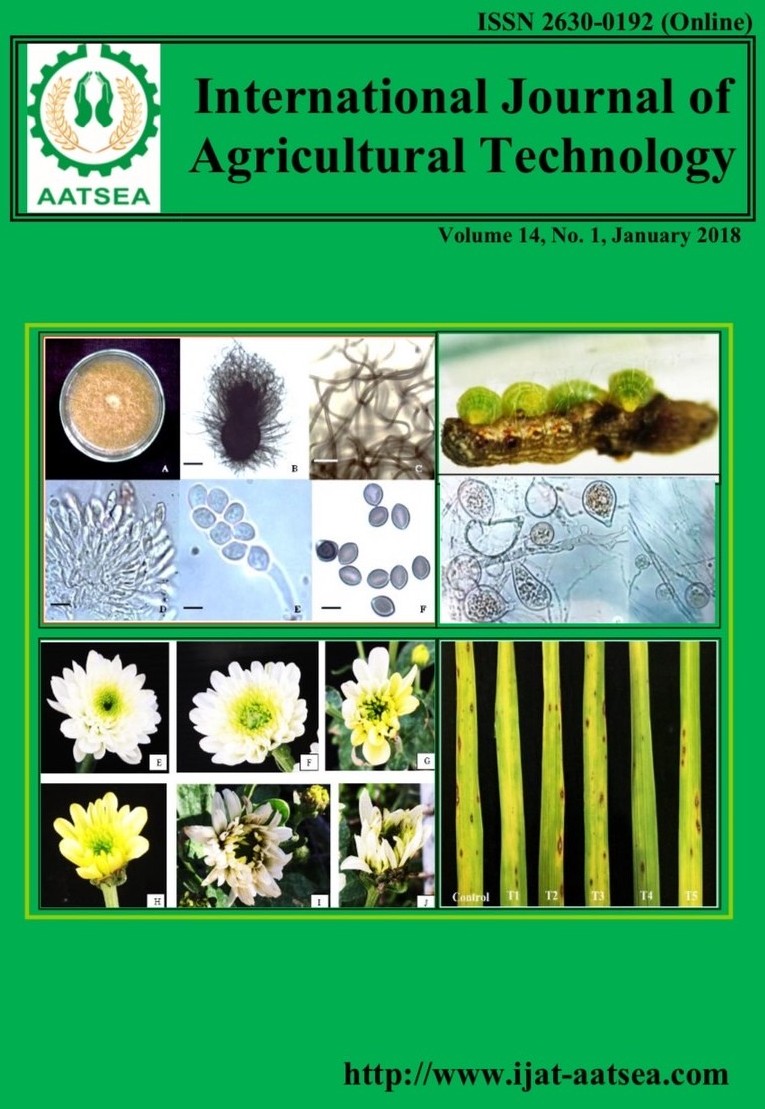Development of the Euplectrus sp. Near Bicolor (Hymenoptera: Eulophidae) on Zonoplusia ochreata (Lepidoptera: Noctuidae)
Main Article Content
Abstract
The larval ectoparasitoid Euplectrus sp. near bicolor (Eulophidae: Hymenoptera), is a gregarious ectoparasitoid of the pennywort cutworm larvae (Zonoplusia ochreata). Biological investigation of Euplectrus sp. near bicolor was conducted in the laboratory (27-35oC; 60-70%RH). The female adults copulated only once for their life time and deposited eggs singly or in clusters of two to eight eggs on the second or third abdominal segment of their larval hosts, which were mostly in the second or third instars. The parasitoids’ eggs had an incubation period of 1.0–3.3 days (2.61 ± 2.10 days). The larvae stayed in a cluster and did not move until they were ready to pupate. The larval period took 2.1–3.8 days (2.82 ± 0.48 days). Pupation occurred on the underside skin of the dead host in a loosely woven silk cocoon that formed in between the host remains and adjacent leaves. The pupal period was ranged from 5.0–7.9 days (6.42 ± 0.89 days). Mating took place immediately after adult emergence, and the adults lived for 2.9–10.8 days (7.51 ± 2.58 days). The total duration of the life cycle from egg to adult emergence was 13.0–25.8 days.
Article Details

This work is licensed under a Creative Commons Attribution-NonCommercial-NoDerivatives 4.0 International License.
References
Askew, R. R., Shaw, M. R. (1986). Parasitoid communities: their size, structure and development. In: Waage, J. K., Greathead, D. J. (Eds.), Insect Parasitoids. Academic Press, New York, pp. 225–264.
Beckage, N. E. (1993). Games parasites play: the dynamic roles of proteins and peptides in the relationship between parasites and host. In: Beckage, N. E., Thompson, S. N., Federici, B. A. (Eds.), Parasites. Parasites and Pathogens of Insects, vol. 1. Academic Press, New York, pp. 25–57.
Coudron, T. A. (1991). Host regulatory factors associated with parasitic Hymenoptera. In: P.A. Hedin (ed), Naturally Occurring Pest Bioregulators. ACS Symposium Series No. 449. pp. 41–65.
Down, R. E., Ford, L., Mosson, H. J., Fitches, E., Gatehouse, J. A. and Gatehouse, A. M. R. (1999). Protease activity in the larval stage of the parasitoid wasp, Eulophus pennicornis (Nee) (Hymenoptera: Eulophidae): effect of protease inhibitors. Parasitology 119:157–166.
Gerling, D. and Limon, S. (1976). A biological review of the genus Euplectrus (Hymenoptera: Eulophidae) with special emphasis on E. laphygmae as a parasite of Spodoptera littoralis (Lepidoptera: Noctuidae). Entomophaga 21:179–187.
Jones, P. and Sands, G.P.A. (1999). Euplectrus melanocephalus Girault (Hymenoptera: Eulophidae, an ectoparasitoid of larvae of fruit-piercing moths (Lepidoptera: Noctuidae: Catocalinae) from northern Queensland. Australian Journal of Entomology 38: 377–381.
Nakamatsu, Y., Fujii, S. and Tanaka, T. (2002). Larvae of an endoparasitoid, Cotesia kariyai (Hymenoptera: Braconidae), feed on the host fat body directly in the second stadium with the help of teratocytes. Journal of Insect Physiology 48:1041–1052.
Nakamatsu, Y. and Tanaka, T. (2003). Venom of ectoparasitoid, Euplectrus sp. near plathypenae (Hymenoptera: Eulophidae) regulates the physiological state of Pseudaletia separata (Lepidoptera: Noctuidae) host as a food resource. Journal of Insect Physiology 49:149–159.
Neser, S., (1973). Biology and behaviour of Euplectrussp. near laphygmaeFerriere (Hymenoptera: Eulophidae). Government Printer. South Africa. 32-31 pp.
Prinsloo, G. L. (1980). An illustrated guide to the families of African Chalcidae (Insecta: Hymenoptera. Science Bulletin Department of Agriculture, Forestry and Fisheries South Africa 395:1–66.
Puttler, B., Gordh, G. and Long, S. H. (1980). Bionomics of Euplectrus puttleri, new species, an introduced parasite of the velvetbean caterpillar, Anticarsia gemmatalis from South America. Annals of the Entomological Society of America 73:28-35.
Rao, V. P., Ghani, M. A., Sankaran, T. and Mathur, K. C. (1971). A review of the biological control of insects and other pests in South-East Asia and the Pacific region. Technical Communication, Commonwealth Institute of Biological Control, Trinidad. 149 pp.
Thompson, S. N. (1993). Redirection of host metabolism and effects on parasite nutrition. In: Beckage, N.E., Thompson, S.N., Federici, B.A. (Eds.), Parasites. Parasites and pathogens of insects, vol.1. Academic Press, New York. pp. 125–144.
Uichanco, L. B. (1934). A twenty- five year balance sheet for economic entomology. The Philippine Agricultural Scientist 23:419–429.
Waddill, V.H. and Puttler, B. (1980). Euplectrus puttleri established on the velvetbean caterpillar Anticarsia gemmatalis in Southern Florida, USA. Environmental Entomology 9:781–782.
Zhuo, Z. H., Yang, W., Qing, H., Yang, C. P., Yang, H. and Xu, D. P. (2013). Effects of venom from Sclerodermus sichuanensis Xiao on pupa of Tenebrio molitor. Chinese Journal of Applied Ecology 24:3273–3297.


